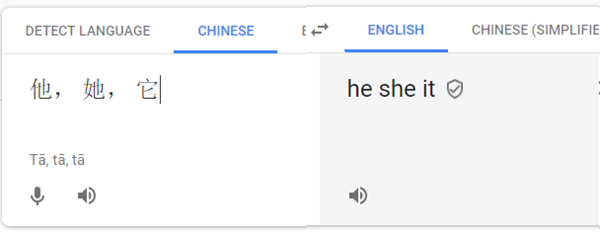Him, her, it, they, and them

In my previous Learning Mandarin post, I discussed personal pronouns and adjectives. Additional useful related words are:
Him, her, it, they, and them
Similar to the way that we have male, female, and other genders for these pronouns, Mandarin has the same concept but what’s interesting is that the spoken words are the same for all of them. The written characters are different for each:
他 (Tā) is the word for “he”.
她 (Tā) is the word for “she”.
Notice that the right-hand side of both characters is the same but the left-hand part differs. In the male version, the left-hand is a squashed form of the character 人 (Rén) which means person. You might recognize it from the Chinese currency 人民币 (Rénmínbì) which is literally “the people’s currency”.
For the female version, the left-hand part (known as a radical) is a squashed form of the character 女 (Nǚ) which means “women”, hence its use in “she”.
For inanimate objects, yet another different written character is used:
它 (Tā) is the word for “it”.
In English, we also change the words depending upon whether they are subjects or objects in a sentence i.e. He did it. I gave it to him.
Mandarin is easier with this because it uses the same words:
他做了。(Tā zuòle) is “He did it”.
把这个给他。(Bǎ zhège gěi tā) is “Give it to him”
And finally, similar to last time, you make these plural by adding 们 (Men) to the end, so
他们 (Tāmen) is the equivalent of “they” when it’s the subject of a sentence, and the equivalent of “them” when it’s the object.
2019-05-24
